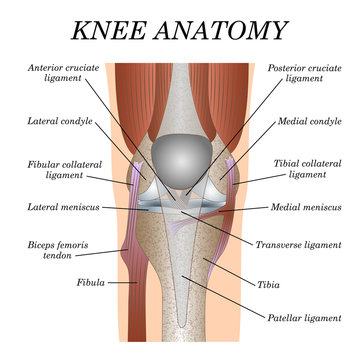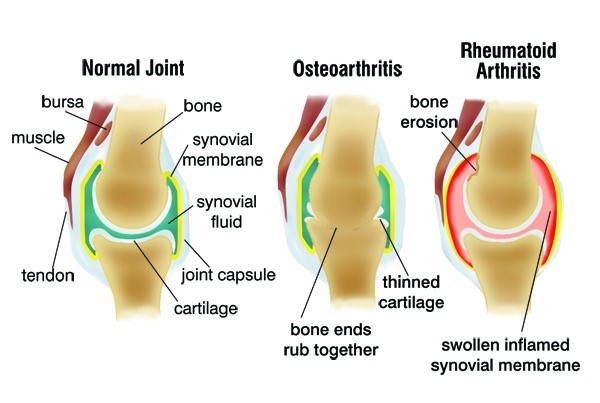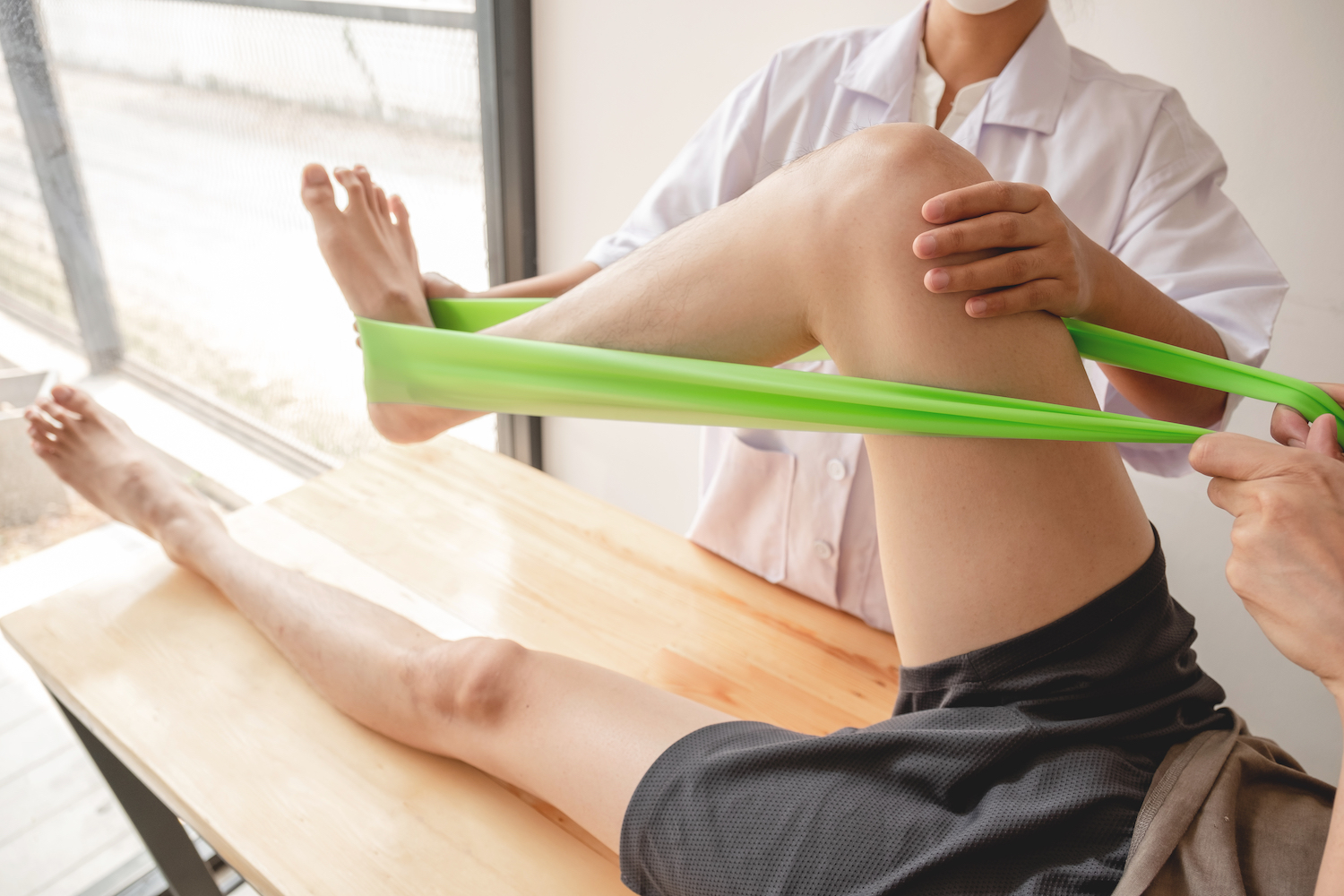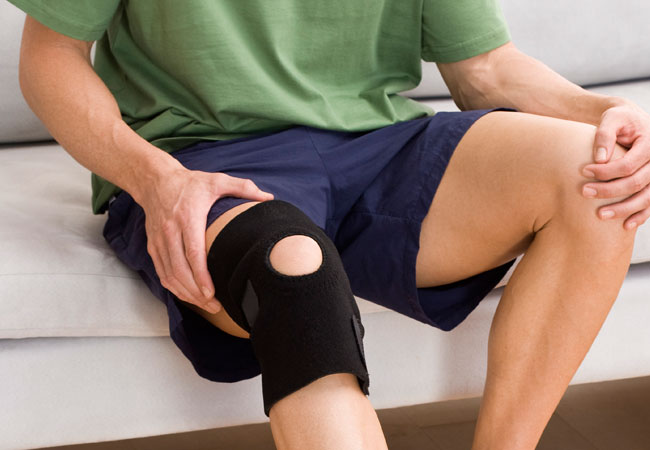McHenry Knee Pain and Problems
Knee pain is a common complaint among adults and is most often associated with general wear and tear from daily activities like walking, bending, standing, and lifting. Athletes who run or play sports that involve jumping or quick pivoting are also more likely to experience knee pain and problems. Whether an individual’s knee pain is caused by aging or injury, it can be a nuisance and even debilitating in some circumstances.
Knee pain is the most common musculoskeletal complaint that brings people to our McHenry physical therapy clinic. With today’s increasingly active society, the number of knee problems is increasing. Knee pain has a wide variety of specific causes and treatments.
Anatomy of the Knee
The knee is a vulnerable joint that bears a great deal of stress from everyday activities, such as lifting and kneeling, and from high-impact activities, such as jogging and aerobics.
The knee joint’s main function is to bend, straighten, and bear the weight of the body, along with the ankles and hips. The knee, more than just a simple hinged joint, however, also twists and rotates. In order to perform all of these actions and to support the entire body while doing so, the knee relies on a number of structures including bones, ligaments, tendons, and cartilage.

Bones
- The knee joint involves four bones.
- The thighbone or femur comprises the top portion of the joint.
- One of the bones in the lower leg, the tibia, provides the bottom weight-bearing portion of the joint.
- The kneecap or patella rides along the front of the femur.
- The remaining bone in the calf, the fibula, is not involved in the weight-bearing portion of the knee joint but provides ligament attachments for stability.
Ligaments
- Ligaments are dense fibrous bands that connect bones to each other.
- The knee includes four important ligaments, all of which connect the femur to the tibia:
- The anterior cruciate ligament (ACL) and posterior cruciate ligament (PCL) provide front and back and rotational stability to the knee.
- The medial collateral ligament (MCL) and lateral collateral ligament (LCL) located along the inner and outer sides of the knee provide medial and lateral stability to the knee.
Tendons
- Tendons are fibrous bands similar to ligaments.
- Instead of connecting bones to other bones as ligaments do, tendons connect muscles to bones.
- The two important tendons in the knee are the quadriceps tendon connecting the quadriceps muscle, which lies on the front of the thigh, to the patella and the patellar tendon connecting the patella to the tibia.
- The quadriceps and patellar tendons are sometimes called the extensor mechanism, and together with the quadriceps muscle they facilitate leg extension.
Cartilage
- Cartilaginous structures called menisci line the top of the tibia and lie between the tibia and the 2 knuckles at the bottom of the femur.
- The menisci’s primary job is to provide cushioning for the knee joint.
What are common knee problems?
Many knee problems we see at our McHenry physical therapy office are a result of the aging process and continual wear and stress on the knee joint, like arthritis. Other knee problems are a result of an injury or a sudden movement that strains the knee. Common knee problems include the following:
- Sprained or strained knee ligaments and/or muscles. A sprained or strained knee ligament or muscle is usually caused by a blow to the knee or a sudden twist of the knee. Symptoms often include pain, swelling, and difficulty in walking.
- Torn cartilage. Trauma to the knee can tear the menisci. Cartilage tears can often occur with sprains. Treatment may involve wearing a brace during an activity to protect the knee from further injury. Surgery may be needed to repair the tear.
- Tendonitis. Inflammation of the tendons may result from overuse of a tendon during certain activities such as running, jumping, or cycling. Tendonitis of the patellar tendon is called jumper’s knee. This often occurs with sports, such as basketball, where the force of hitting the ground after a jump strains the tendon.
- Arthritis. Osteoarthritis is the most common type of arthritis that affects the knee. Osteoarthritis is a degenerative process where the cartilage in the joint gradually wears away. It often affects middle-age and older people. Osteoarthritis may be caused by excess stress on the joint such as repeated injury or being overweight. Rheumatoid arthritis can also affect the knees by causing the joint to become inflamed and by destroying the knee cartilage. Rheumatoid arthritis often affects persons at an earlier age than osteoarthritis.

Symptoms of a Knee Injury
The type of pain and where you feel it in your knee can vary depending on what the problem is. Our McHenry physical therapists will evaluate your symptoms and medical history to determine the nature and severity of your soft tissue injury. Knee pain, along with the following symptoms, are most common:
- Pain, usually when you bend or straighten the knee
- Swelling
- Trouble putting weight on the knee
- Problems moving your knee
- Knee buckling or “locking”
- Immediate pain along with immediate or delayed swelling
- Instability or a feeling that the knee may “give out”
- Pain in surrounding bony structures
- Stiffness
- Bruising
How can a McHenry Physical Therapist help my Knee Pain?

If your knee pain doesn’t go away, our top-rated physical therapists may suggest treatments to tackle the underlying cause of your knee pain. This may involve trying to make your hip muscles stronger or help with foot problems, each of which can affect knee pain. Our experienced physical therapists will suggest treatment based on the condition that’s causing your pain.
Strengthening the muscles around your knee will make it more stable. Our McHenry physical therapists may recommend different types of strengthening exercises based on the specific condition that is causing your knee pain.
If you are physically active or play a sport, you may need exercises to correct movement patterns that may be affecting your knees and to establish good technique during your sport or activity. Exercises to improve your flexibility and balance also are important.
Some types of therapy mainly focus on the muscles in the back and front of your thighs. Physical therapy for muscle strengthening is also needed to prevent recurrent dislocations. Sports activities and exercises are used as treatment therapies. It is important to practice exercises that will improve your balance.
Though physical therapy treatment for knee joint pain may take a while before it becomes effective, it is the best as it uses natural methods to heal the knee. Physical therapy is non-invasive and has minimal risk involved, unlike other forms of treatments.
When Should I go to Physical Therapy for my Knee Injury?
Knee pain can go away without further medical treatment, using only a few self-help measures.
If your knee pain persists and you need professional help, it might be time to go see a physical therapist. You might first see a nearby McHenry physical therapist or your general practitioner.
See a physical therapist near you if:
- you’re in severe pain
- your painful knee is swollen
- it doesn’t get better after a few weeks
- you can’t move your knee
- you can’t put any weight on your knee
- your knee locks, clicks painfully or gives way – painless clicking is not unusual and is nothing to worry about.
What to Expect from your McHenry Physical Therapy Treatment

Knee physical therapy can help the knee issues and pain you’re experiencing, including buckling, weakness, swelling, and popping. A McHenry area physical therapist who specializes in knees can treat your knee condition using the safest and most effective treatments.
Knee physical therapy may eliminate knee pain and injury so that patients won’t need to seek risky treatments such as surgeries, medications, or injections.
When you see a physical therapist near you, who specializes in knee conditions, you are in the care of an expert who knows everything there is to know about the knees. Physical therapists are certified healthcare professionals who can determine the cause of your knee troubles and give you the best type of treatment available to heal your knees.
During your initial appointment, your nearby McHenry physical therapist will guide you through a physical examination, testing, and questions related to your knee problems. The questions and testing will help your physical therapist make an accurate diagnosis and pinpoint the cause of your knee troubles.
Many knee pain “treatments” focus on fixing the symptoms of knee problems rather than the cause. When only the symptoms are treated, your knee problems will likely return or worsen.
Talk to you about your Knee issues
Our top-rated physical therapists collect information from the initial appointment to determine and fix the cause of your knee pain. This cause-based approach will prevent reoccurring pain and promote happy, healthy knees.
Many patients try treatments such as heat/cold packs, medications, rest, or surgery prior to visiting a physical therapist near you. Often, these treatments are not sufficient in healing the knee injury since they typically don’t fix the cause of the injury.
Your McHenry physical therapist can provide you with a solution that prevents knee problems from reoccurring.
Your physical therapist may ask some of the following questions:
- Do you exercise or play sports?
- Was the pain caused by an injury?
- Do you experience any swelling, instability or locking of the knee?
- Are you experiencing symptoms in other areas, or just in your knee?
- Have you ever had knee pain before? If so, do you know what the cause was?
Movements and Stretching
Your physical therapist will guide you through movements and stretches that test your range of motion. Pain-causing knee stiffness is often due to poor range of motion in the knee or other areas in the body.
Functional and muscular strength tests reveal how well you can physically function with your injury. You will perform various types of physical activities during these tests.
One way that your physical therapist may test your strength is to have you push inwards or outwards with your leg into his or her hands.
You will perform functional and muscular strength tests during the initial visit and routinely throughout your physical therapy program to assess the progression of healing.
Your physical therapist will use information from the initial questions and tests along with her observations to accurately detect the cause of your knee condition.
Often, knee conditions are not caused directly by injury in the knees themselves, but from issues in other parts of the body (such as poor mobility in the feet/ankles or weak muscles in the hips). This fact makes it tricky for non-physical therapists to diagnose and treat knee conditions.
Physical therapy may help your knee pain, depending on what has caused it and what part of your knee hurts. A McHenry physical therapist can provide advice on our services tailored to your individual situation.
Physical Therapy Treatment Options
Treatments your physical therapist may suggest include:
- a programme of exercises tailored to your particular needs – depending on what’s causing your knee pain, this may need to last for a while
- taping of the kneecap – this involves applying adhesive tape over the kneecap to change the way your kneecap sits or moves
- knee braces – you can buy these from sports shops, chemists and online retailers, but they’re not suitable for everyone or for all knee problems.
Myofascial Release
If tight muscles are the cause of your knee condition, the most advanced physical therapists can perform myofascial release, which is a special manual technique that breaks up the muscle tissues to reduce tightness and pain.
Patient Education
Sometimes, patients need proper education on how to squat, walk, and exercise properly, and which types of shoes they should and shouldn’t wear. Physical therapists will share their knowledge to help patients recover sooner.
Contact a McHenry Physical Therapist about Knee Pain
Contacting a physical therapist is the best way to treat most knee injuries.
Physical therapy for knee pain is considered a first-line treatment for many knee conditions because it can help prevent unnecessary surgeries, medications, and invasive treatments.
Physical therapy for the knees can quickly alleviate pain and provide lasting benefits that other treatments can’t offer. Patients will leave with stronger, more flexible, and mobile knees that are less prone to reinjury.
Fill out the form below or give us a call to get back to living pain-free.
McHenry Knee Pain Treatment Patient Review
Red Rock Physical Therapy is a gem tucked away in McHenry. The staff is knowledgeable and friendly. They are willing to work with your schedule to get you in to receive care. They are concerned with your well being and safety. I recommend them to anyone needing physical therapy.
Shawn Smosna
Rating: 5/5 ⭐⭐⭐⭐⭐
Client: Shawn Smosna
Read more of our client reviews on our Google profile!
